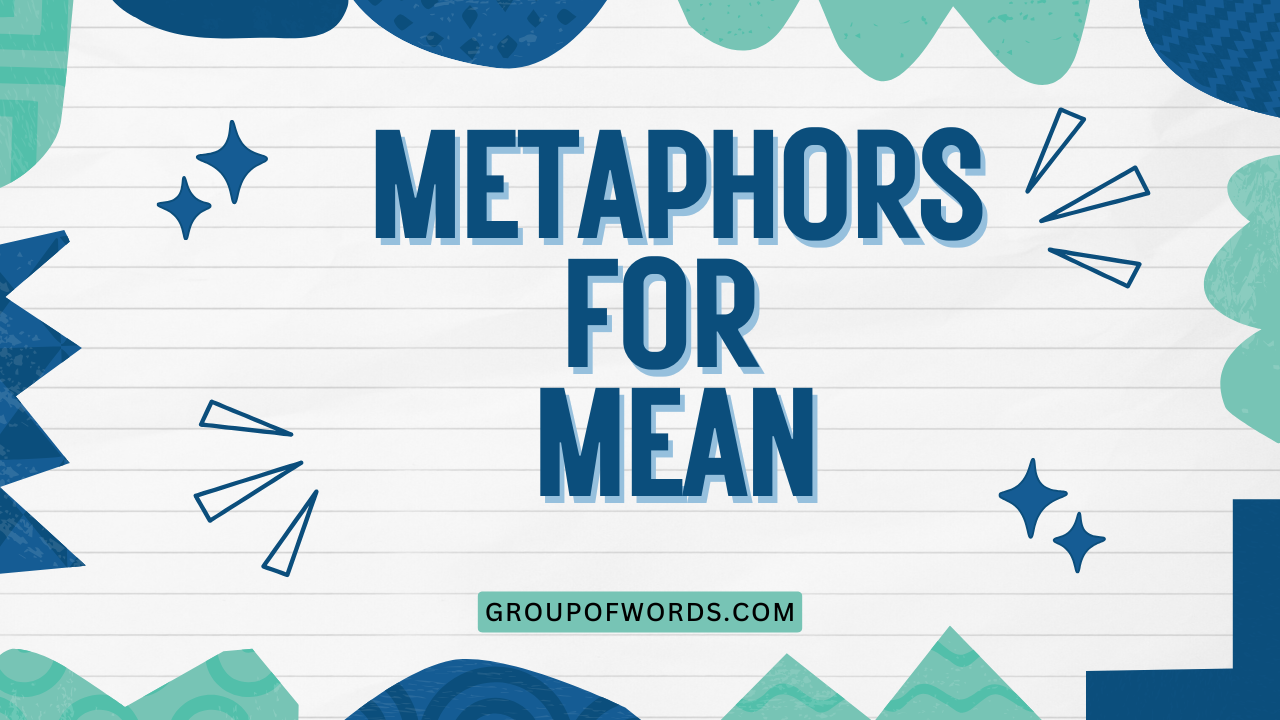Metaphors for “Mean”: A Comprehensive Guide
Understanding the nuances of the word “mean” is crucial for effective communication. “Mean” can express various concepts, from intentions and averages to unpleasant behavior.
This article explores the different metaphorical uses of “mean,” providing a comprehensive guide for English language learners and those seeking to refine their understanding of this versatile word. By examining its diverse applications, we aim to clarify its meaning in different contexts and equip you with the knowledge to use it accurately and confidently.
This guide is particularly beneficial for students, writers, and anyone who wants to improve their English language skills.
Table of Contents
- Introduction
- Definition of “Mean”
- Structural Breakdown
- Types or Categories of “Mean”
- Examples of “Mean” in Use
- Usage Rules for “Mean”
- Common Mistakes with “Mean”
- Practice Exercises
- Advanced Topics
- Frequently Asked Questions
- Conclusion
Definition of “Mean”
The word “mean” is a versatile term with multiple meanings, making it essential to understand its different contexts. It can refer to intention, average, or unpleasant behavior.
Each meaning has its own specific usage and connotations.
Meaning as Intention
In this context, “mean” signifies purpose or intention. It is often used with the infinitive form of a verb (to + verb) to indicate what someone intends to do or achieve.
For example, “I didn’t mean to hurt you” expresses that the speaker did not intend to cause harm.
Meaning as Average
When used in a mathematical sense, “mean” refers to the average of a set of numbers. It is calculated by adding all the numbers together and dividing by the total number of values.
For example, the mean of 2, 4, and 6 is (2+4+6)/3 = 4.
Meaning as Unpleasant or Cruel
In everyday language, “mean” often describes someone who is unkind, unpleasant, or cruel. It indicates a lack of empathy or consideration for others’ feelings.
For example, “He was being mean to his sister” suggests that he was behaving in an unkind or cruel manner towards her.
Structural Breakdown
Understanding the structural elements of “mean” involves examining its agreement with subjects, its use in prepositional phrases, and its behavior across different verb tenses. These elements are crucial for constructing grammatically correct sentences.
Subject-Verb Agreement
“Mean” follows standard subject-verb agreement rules. When used as a verb indicating intention, it changes form depending on the subject pronoun.
For example, “I mean,” “he means,” “we mean.” In the context of average, the calculation remains constant regardless of the subject. When describing unpleasant behavior, the verb form aligns with the subject as well.
Prepositional Phrases with “Mean”
Prepositional phrases involving “mean” can alter its meaning and usage. For instance, “mean to” indicates intention, while “mean for” suggests suitability or purpose.
“What do you mean by that?” uses “by” to ask for clarification. Understanding these nuances is essential for precise communication.
Verb Tenses and “Mean”
“Mean” can be used in various verb tenses to indicate different time frames. “I meant to call you” (past tense) expresses a past intention.
“I am meaning to call you” (present continuous) suggests a current intention. “I will mean to call you” (future tense) expresses a future intention.
The tense used depends on the context and the time frame you want to convey.
Types or Categories of “Mean”
The word “mean” appears in several idiomatic expressions and fixed phrases, each with a distinct meaning. Understanding these phrases can significantly improve your comprehension and usage of the English language.
Mean-Spirited
“Mean-spirited” describes someone who is deliberately unkind or cruel. It suggests a malicious intent to cause harm or distress.
This term often carries a strong negative connotation.
Mean Streak
A “mean streak” refers to a temporary period of unkind or cruel behavior. It suggests that someone is not typically mean but is exhibiting such behavior at a particular time.
This term implies a departure from the person’s usual character.
Mean Business
“Mean business” implies that someone is serious and determined about achieving a goal. It suggests that they are not to be taken lightly and are committed to their objective.
This phrase often conveys a sense of authority and resolve.
Examples of “Mean” in Use
To illustrate the different meanings of “mean,” here are several examples organized by category. These examples will help you understand how to use “mean” correctly in various contexts.
“Mean” as Intention
The following table provides examples of “mean” used to express intent. Notice how “mean to” is followed by a verb in its infinitive form.
| Sentence | Explanation |
|---|---|
| I didn’t mean to interrupt you. | The speaker did not intend to interrupt. |
| She meant to call you yesterday, but she forgot. | She intended to call, but she didn’t. |
| Did you mean to leave the door open? | Are you asking if it was their intention to leave the door open? |
| He meant to finish the project by Friday. | His intention was to complete the project by Friday. |
| We didn’t mean to cause any trouble. | Our intention was not to create any problems. |
| They meant to arrive earlier, but they were delayed. | Their intention was to arrive early, but they were late. |
| I mean to get this done today. | I intend to complete this task today. |
| She means to apply for the scholarship. | She intends to submit an application for the scholarship. |
| He means to travel to Europe next year. | He intends to visit Europe in the upcoming year. |
| They mean to start their own business. | Their intention is to launch their own company. |
| I didn’t mean to offend you with my comment. | My intention was not to upset you with my remark. |
| She didn’t mean to spill the coffee on your shirt. | She did not intend to cause the coffee to stain your shirt. |
| Did you mean to send the email to the wrong person? | Was it your intention to mistakenly send the email? |
| He didn’t mean to break the vase. | He did not intend to shatter the vase. |
| We didn’t mean to wake you up so early. | Our intention was not to rouse you from sleep so early. |
| They didn’t mean to miss the train. | Their intention was not to be late for the train. |
| I mean to learn how to play the guitar. | I intend to acquire the skill of playing the guitar. |
| She means to improve her French. | She intends to enhance her proficiency in French. |
| He means to get in shape for the summer. | He intends to become physically fit before summer arrives. |
| They mean to buy a new house next year. | Their intention is to purchase a new home in the coming year. |
“Mean” as Average
The following table provides examples of “mean” used in a mathematical context to denote the average of a set of numbers.
| Sentence | Explanation |
|---|---|
| The mean score on the test was 75. | The average score of all test takers was 75. |
| What is the mean temperature for the month? | What is the average temperature for the month? |
| The mean income in this city is quite high. | The average income of residents in this city is high. |
| Calculate the mean of these numbers: 2, 4, 6, 8, 10. | Find the average of the given numbers. |
| The mean weight of the apples is 150 grams. | The average weight of the apples is 150 grams. |
| The mean age of the students is 22 years. | The average age of the students is 22 years. |
| The mean rainfall for the year was 30 inches. | The average amount of rain that fell throughout the year was 30 inches. |
| The mean distance from the Earth to the Moon is 238,900 miles. | The average separation between the Earth and the Moon is 238,900 miles. |
| The mean salary for teachers in this district is $60,000. | The average wage paid to teachers in this district is $60,000. |
| The mean value of these houses is $500,000. | The average price of these homes is $500,000. |
| The mean number of customers per day is 200. | The average daily customer count is 200. |
| The mean time to complete the task was 3 hours. | The average duration to finish the task was 3 hours. |
| The mean height of the basketball team is 6’5″. | The average height of the players is 6 feet 5 inches. |
| The mean GPA of the graduating class was 3.5. | The average Grade Point Average for the graduating students was 3.5. |
| The mean waiting time at the doctor’s office is 20 minutes. | The average amount of time patients wait is 20 minutes. |
| The mean lifespan of a dog is 12 years. | The average age a dog lives is 12 years. |
| The mean price of gasoline this week is $3.50 per gallon. | The average cost for a gallon of gasoline this week is $3.50. |
| The mean number of books read per year is 15. | The average number of books read annually is 15. |
| The mean commute time to work is 30 minutes. | The average travel time to work is 30 minutes. |
| The mean score in the video game was 10,000 points. | The average score in the video game was 10,000 points. |
“Mean” as Unpleasant or Cruel
The following table provides examples of “mean” used to describe someone who is unkind, unpleasant, or cruel. Note the negative connotations associated with this usage.
| Sentence | Explanation |
|---|---|
| Don’t be so mean to your brother. | Don’t be unkind to your brother. |
| She said some very mean things to me. | She said some very unkind things to me. |
| He’s a mean person who enjoys hurting others. | He’s an unkind person who likes to cause pain. |
| Why are you being so mean today? | Why are you being so unkind today? |
| It was mean of you to laugh at him. | It was unkind of you to laugh at him. |
| The bully was being mean to the younger students. | The bully was being unkind to the younger students. |
| She has a mean streak that comes out sometimes. | She occasionally exhibits unkind behavior. |
| He gave me a mean look. | He gave me an unkind expression. |
| That was a mean thing to say. | That was an unkind thing to say. |
| Don’t be mean; share your toys. | Don’t be unkind; let others play with your toys. |
| He is a mean boss who yells at his employees. | He is an unkind supervisor who shouts at workers. |
| She is a mean girl who spreads rumors. | She is an unkind adolescent who circulates gossip. |
| It’s mean to exclude someone from the game. | Excluding someone from the game is unkind. |
| He was being mean to the animals at the zoo. | He was treating the animals unkindly at the zoo. |
| Don’t be mean to yourself; you’re doing great. | Be kind to yourself; you’re progressing well. |
| She can be quite mean when she’s angry. | She tends to be unkind when she is upset. |
| It’s mean to make fun of someone’s appearance. | Teasing someone about their looks is unkind. |
| He has a reputation for being mean and selfish. | He is known for being unkind and egocentric. |
| She tried not to be mean, but she was frustrated. | She attempted to be kind, but her frustration overcame her. |
| The teacher was mean to the student for being late. | The teacher was unkind to the student for tardiness. |
Idiomatic Expressions with “Mean”
The following table illustrates some common idiomatic expressions that use the word “mean.”
| Idiom | Meaning | Example Sentence |
|---|---|---|
| Mean business | To be serious and determined | He’s wearing his serious face; he means business. |
| What do you mean? | Asking for clarification | I don’t understand. What do you mean? |
| Mean to say | Intend to express | I didn’t mean to say that, it just came out wrong. |
| By all means | Certainly; of course | “Can I borrow your pen?” “By all means.” |
| No mean feat | A difficult achievement | Climbing Mount Everest is no mean feat. |
| Mean time | Average or midpoint in time | The mean time between failures for this machine is 500 hours. |
| Mean well | Have good intentions | He may be clumsy, but he means well. |
| What does that mean? | Asking for the definition | I don’t know that word. What does that mean? |
| Somewhere in between | A middle ground | It wasn’t too hot, it wasn’t too cold, it was somewhere in between. |
| Get your meaning across | To communicate effectively | He struggled to get his meaning across in the presentation. |
| A means to an end | Something done to achieve something else | Working overtime was a means to an end: saving enough for a vacation. |
| Mean something to someone | To be important to someone | This old photograph means a lot to me. |
| Mean the world to someone | To be extremely important to someone | Your support means the world to me. |
| In the meantime | During the intervening period of time | The doctor will see you soon; in the meantime, please take a seat. |
| By no means | In no way; not at all | By no means was I trying to upset you. |
| What do you mean by that? | Asking for explanation of a statement | “I think we should reconsider our strategy.” “What do you mean by that?” |
| What’s the meaning of this? | Expressing surprise or anger at a situation | The house was a mess. “What’s the meaning of this?” she asked. |
| You know what I mean? | Asking for confirmation of understanding | It’s a tough situation, you know what I mean? |
| That means a lot | Expressing appreciation | Thank you for your help; that means a lot. |
| Mean to each other | To be unkind to each other | The siblings were often mean to each other. |
Usage Rules for “Mean”
To use “mean” correctly, it’s essential to understand the specific rules that govern its usage in different contexts. This section outlines the key rules for each meaning of “mean.”
Intention: “Mean to” vs. “Mean for”
When expressing intention, use “mean to” followed by the base form of the verb. “Mean for” indicates suitability or purpose.
For example, “I meant to call you” (intention) vs. “This gift is meant for you” (purpose).
Average: Correct Context
Ensure that you are using “mean” in a context where calculating the average is appropriate. It is used in mathematics, statistics, and other fields where numerical data is analyzed.
Avoid using “mean” to describe the middle value in a non-numerical context.
Unpleasant: Appropriate Tone
When using “mean” to describe someone as unkind, be mindful of the tone. It is a strong word and should be used carefully to avoid causing unnecessary offense.
Consider the context and your relationship with the person you are describing.
Common Mistakes with “Mean”
Even experienced English speakers sometimes make mistakes when using “mean.” This section addresses some common errors and provides correct examples.
Misusing “Mean to” and “Mean for”
A common mistake is confusing “mean to” and “mean for.” Remember that “mean to” expresses intention, while “mean for” indicates suitability or purpose.
Incorrect: I meant for call you.
Correct: I meant to call you.
Incorrect: This tool is meant to fix the car.
Correct: This tool is meant for fixing the car/This tool is meant to fix the car.
Incorrect Calculation of Average
Another common mistake is incorrectly calculating the average. Ensure that you add all the numbers together and divide by the correct number of values.
Incorrect: The mean of 2, 4, and 6 is 12.
Correct: The mean of 2, 4, and 6 is 4. (2+4+6 = 12; 12/3 = 4)
Using “Mean” Inappropriately
Using “mean” in an inappropriate context can lead to misunderstandings. Be sure that the situation warrants the use of such a strong word.
Inappropriate: The weather is so mean today.
Better: The weather is so unpleasant today.
Practice Exercises
Test your understanding of “mean” with these practice exercises. Each exercise focuses on a different aspect of the word’s usage.
Exercise 1: Fill in the Blanks
Fill in the blanks with the correct form of “mean.”
| Question | Answer |
|---|---|
| I didn’t ______ to hurt your feelings. | mean |
| What does this word ______? | mean |
| The ______ temperature for July is 80 degrees. | mean |
| He can be very ______ when he’s angry. | mean |
| She ______ to finish the report by Friday. | means |
| They ______ business when they say they’re going to win. | mean |
| What do you ______ by saying that? | mean |
| He didn’t ______ to be rude. | mean |
| This gift is ______ for you. | meant |
| The ______ score on the test was 85. | mean |
Exercise 2: Sentence Correction
Correct the sentences that use “mean” incorrectly.
| Incorrect Sentence | Correct Sentence |
|---|---|
| I mean for call you later. | I meant to call you later. |
| The mean of 1, 3, and 5 is 6. | The mean of 1, 3, and 5 is 3. |
| He’s so mean, I love him. | He’s so unkind, I dislike him. |
| She meant for go to the store. | She meant to go to the store. |
| The weather is very mean today. | The weather is very unpleasant today. |
| I meaned to tell you about the party. | I meant to tell you about the party. |
| What do you meaning? | What do you mean? |
| The meanest number is 7. | (Sentence doesn’t make sense. Numbers are not mean.) |
| He meaned well, but he messed up. | He meant well, but he messed up. |
| They are meaning to go to Europe. | They mean to go to Europe. |
Exercise 3: Sentence Writing
Write sentences using “mean” in the following contexts:
| Context | Your Sentence |
|---|---|
| Expressing an intention | I mean to finish this book this week. |
| Calculating an average | The mean of 10, 20, and 30 is 20. |
| Describing someone unkind | He was being mean to his younger sister. |
| Asking for clarification | What do you mean by that statement? |
| Using the idiom “mean business” | The coach means business this season. |
| Using “mean well” | She means well, even if her actions are misguided. |
| Describing something important | This necklace means a lot to me. |
| Expressing something not intended | I didn’t mean to make you cry. |
| Expressing determination | I mean to succeed in this endeavor. |
| Describing a difficult task | Completing this project on time is no mean feat. |
Advanced Topics
For advanced learners, this section delves into more complex aspects of “mean,” including subtle nuances and its etymology.
Subtle Nuances of “Mean”
The word “mean” can convey subtle nuances depending on the context and tone. For instance, saying “He can be mean” implies a general tendency, while “He is being mean” suggests a specific instance of unkind behavior.
Understanding these subtleties can enhance your communication skills.
Etymology of “Mean”
The word “mean” has a rich etymological history, tracing back to Old English and Germanic roots. It originally meant “common” or “shared,” which evolved into meanings related to intention and average.
Exploring its etymology provides a deeper appreciation for the word’s evolution and versatility.
Frequently Asked Questions
Here are some frequently asked questions about the word “mean.”
- What is the difference between “mean to” and “mean for”?
“Mean to” expresses intention, while “mean for” indicates suitability or purpose. For example, “I meant to call you” (intention) vs. “This gift is meant for you” (purpose).
- How do I calculate the mean of a set of numbers?
To calculate the mean, add all the numbers together and divide by the total number of values. For example, the mean of 2, 4, and 6 is (2+4+6)/3 = 4.
- When is it appropriate to use “mean” to describe someone?
Use “mean” to describe someone when they are consistently unkind, unpleasant, or cruel. Be mindful of the tone and avoid using it casually, as it can be offensive.
- What does it mean to “mean business”?
To “mean business” implies that someone is serious and determined about achieving a goal. It suggests that they are not to be taken lightly and are committed to their objective.
- What is a “mean streak”?
A “mean streak” refers to a temporary period of unkind or cruel behavior. It suggests that someone is not typically mean but is exhibiting such behavior at a particular time.
- Can “mean” be used in a positive context?
While “mean” often has negative connotations, it can be used in a positive context when referring to the average or in idiomatic expressions like “mean well.”
- What does “What do you mean?” mean?
The phrase “What do you mean?” is a request for clarification. It asks the speaker to explain their statement or idea further.
- Is it correct to say “I meaned to do that”?
No, the correct past tense form of “mean” when expressing intention is “meant.” Therefore, the correct sentence is “I meant to do that.”
Conclusion
Understanding the multiple meanings and usages of “mean” is crucial for effective communication in English. From expressing intentions and calculating averages to describing unkind behavior, “mean” is a versatile word with diverse applications.
By mastering the rules and nuances discussed in this article, you can confidently use “mean” in various contexts and avoid common mistakes. Continue practicing and exploring different examples to solidify your understanding and enhance your language skills.
Remember to pay attention to context and tone to ensure your message is conveyed accurately and appropriately.






